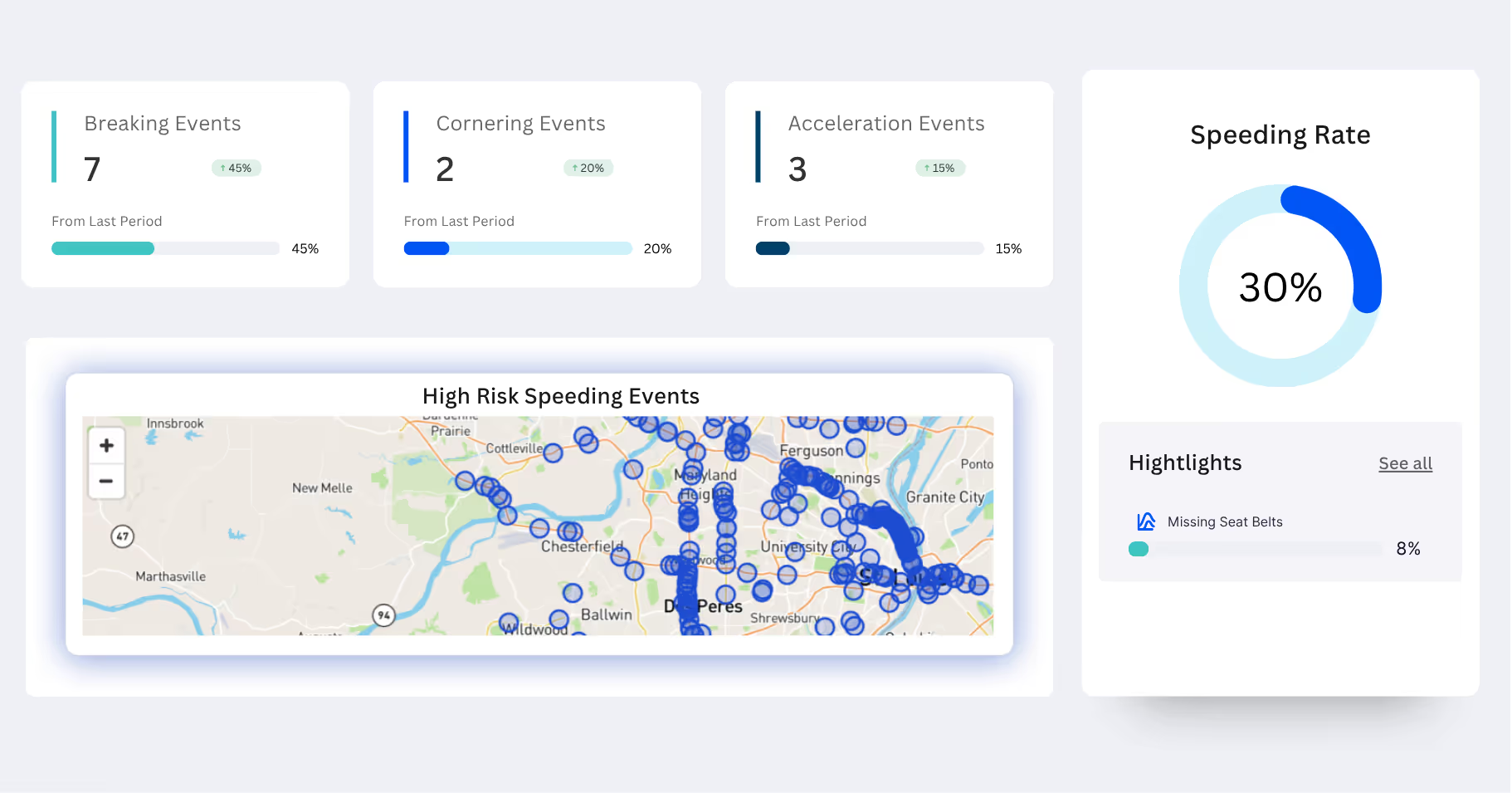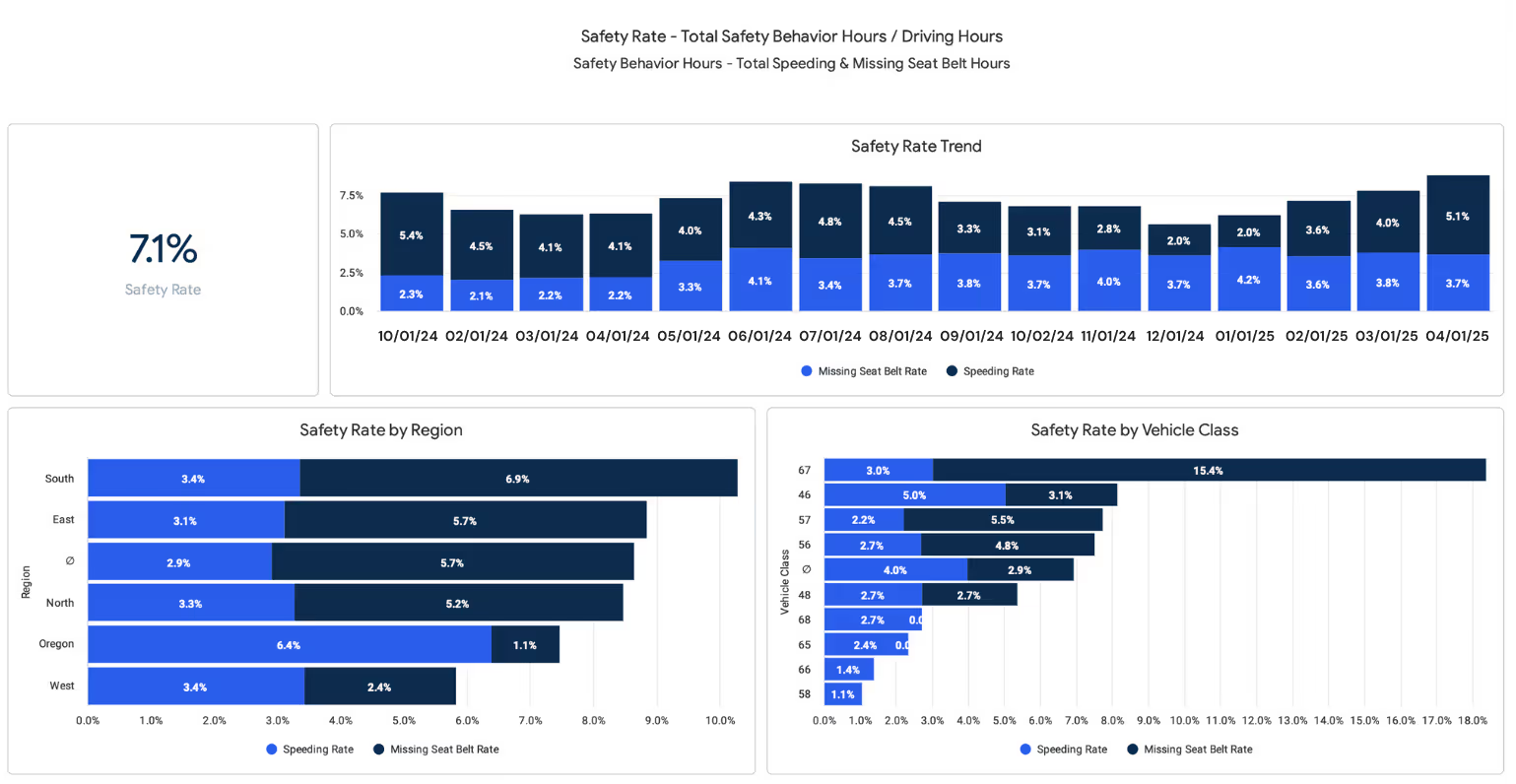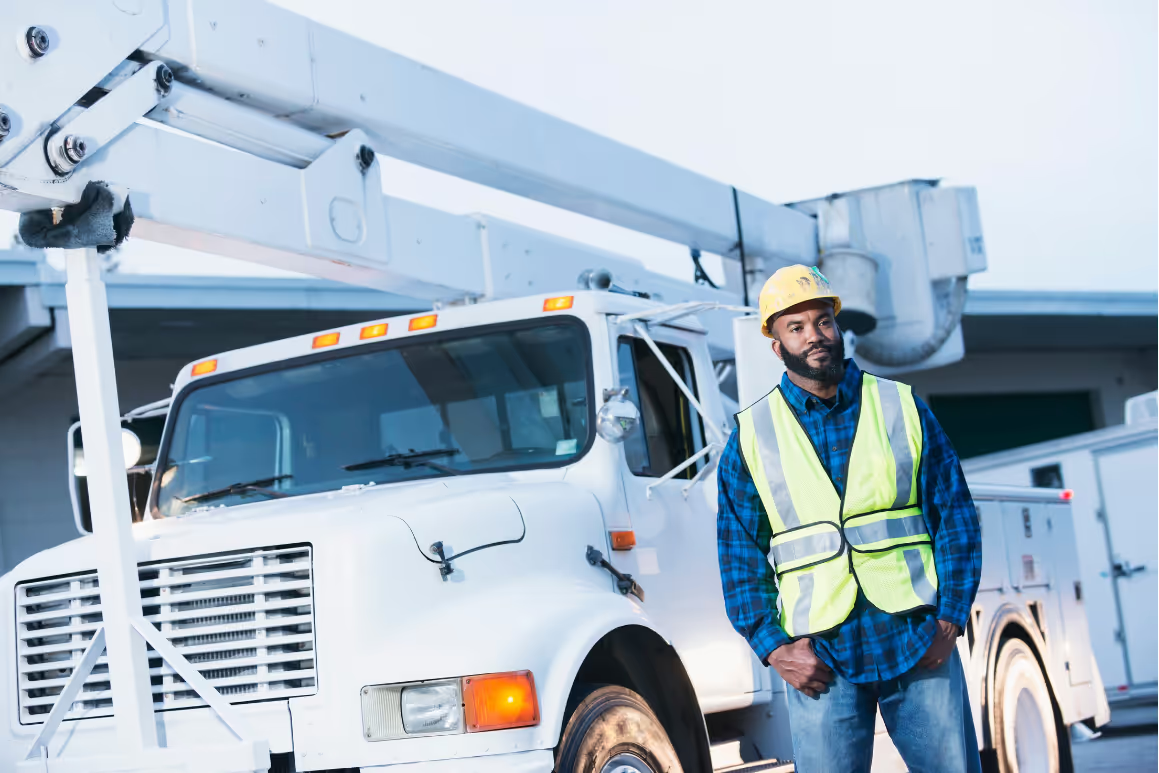Fleet safety remains a top priority across both public and private sectors. Motor vehicle incidents continue to be one of the leading causes of occupational fatalities in the United States. Despite long-standing regulations, training programs, and compliance efforts, real-world incidents highlight how fragile fleet operations can be and how urgently new solutions are needed.
This article explores recent safety incidents and how AI, fleet technology, and connected data systems are being used to help prevent them. Learn how a proactive, integrated approach to fleet safety is helping organizations mitigate risk and incidents.
Real Incidents: What They Teach Us
1. Road Maintenance Danger, Louisiana – June 2025: A terrifying June 2025 incident in Louisiana highlighted the dangers faced by road maintenance crews. A highway utility worker was elevated in a bucket repairing a traffic light when an 18-wheeler made a left turn and slammed into the raised bucket.
Dashcam footage captured the moment the bucket arm was struck and collapsed, leaving the worker dangling upside-down by his safety harness above the intersection. Remarkably, the Louisiana Department of Transportation employee survived with only minor injuries, thanks in part to the mandated use of harnesses.
A witness, who shared the video on social media, wrote: “We never expected to see this today while waiting for a green light”.
2. Utility Workers Killed, North Carolina – April 2025: Four utility workers were killed and three others severely injured when a dump truck drove through a temporary roadside work zone, failing to stop at a marked intersection. Among those struck was a lineman working from an aerial bucket. Preliminary findings from the National Transportation Safety Board (NTSB) revealed that the city-operated dump truck entered the work zone without braking.
3. Multi-Vehicle Crash, Wyoming – February 2025: Three people were killed and more than twenty injured in a multi-vehicle crash and fire inside a highway tunnel after several commercial trucks collided during snowy and icy conditions. One pickup lost control, triggering a chain reaction that left tractor-trailers unable to stop in time.
4. Warehouse/Construction Fatality, Georgia – March 2025: Tragedy struck at an industrial construction site in March 2025 when a worker was fatally hit by a forklift at the Hyundai “Megaplant” construction project in Georgia. Two workers reported that a forklift struck a 45-year-old man on the job site, inflicting fatal injuries.
Recent data show that forklifts cause dozens of deaths every year (67 work-related forklift fatalities in the most recent year on record) along with tens of thousands of injuries.

Safety agencies estimate that roughly 70% of forklift incidents could be prevented with proper training and safety protocols, underscoring the need for better oversight in industrial fleet operations.
5. Highway Work Site Accident, Michigan – June 2025: A 23-year-old road construction worker in Michigan was killed after being struck by an excavator bucket on a highway job site. The excavator’s operator reportedly did not see the young worker on foot before the bucket hit him, suggesting a lapse in visibility and communication on the site.
6. Trucking Collision, Michigan – June 2025: Following a crash, two men in a commercial box truck lost their lives when their vehicle plowed into the back of a semi-truck on I-94 in Michigan. The box truck struck the rear of a semi hauling gravel at highway speed, causing a catastrophic crash – the smaller truck’s cab was destroyed and its fuel tank ruptured, spilling diesel on the road.
While the specific cause was not released, such rear-end collisions on highways are often linked to driver inattention or following too closely. Despite new technologies, many crashes still boil down to drivers taking their eyes off the road or traveling too fast, which greatly magnifies the severity of any impact.
Data from the National Safety Council confirms that speed is a factor in roughly 28% of fatal crashes – a sobering statistic that reinforces why tackling these behaviors is so critical.
Core Causes: Patterns Across Industries
Across these incidents, the root causes span several recurring themes:
- Lack of driver awareness
- Environmental factors
- Insufficient hazard detection or warning systems
- Disconnected data sources or limitations between vehicles, infrastructure, and field crews
These incidents, from utility bucket operators to warehouse workers to truck drivers, show that fleet safety challenges cut across all sectors. Whether it’s a public employee fixing a stoplight or a freight team on the highway, the dangers are real and often life-threatening.
A Changing Safety Landscape
According to the National Highway Traffic Safety Administration (NHTSA), motor vehicle fatalities involving large trucks remain a significant concern, with work-related transportation incidents continuing to account for over 35% of all occupational fatalities in the U.S. as of 2024.
Agencies like the Federal Motor Carrier Safety Administration (FMCSA) have begun emphasizing data-driven risk management strategies over reactive compliance alone. The focus has shifted from documenting incidents to preventing them—using new tech, predictive analytics, real-time monitoring tools, and integrated data.
What Data Matters for Fleet Safety?
Not all data is created equal. The most effective fleet safety programs focus on a few key categories:
1. Telematics Data: Telematics systems collect data on vehicle speed, harsh braking, idling, route history, and more. This foundational data enables AI systems to spot unsafe patterns and high-risk behaviors long before an incident occurs.
2. Driver Behavior Data: Real-time monitoring of driving habits such as distraction, fatigue, and aggressive acceleration is becoming increasingly important. According to the Transportation Research Board (TRB), behavior-based safety programs using in-cab monitoring systems have helped reduce incidents by as much as 20% when paired with proactive coaching.
3. Vehicle Health and Diagnostic Data: Predictive maintenance alerts generated from engine diagnostics and sensor readings help prevent failures that could lead to roadside breakdowns or safety-critical situations. The Department of Energy (DOE) noted in 2025 that fleets using predictive diagnostics reduced safety-related vehicle failures by nearly 30%.
4. Environmental and Contextual Data: External factors like road conditions, weather, and traffic patterns can now be layered with internal fleet data to improve decision-making. When analyzed by AI, this information can dynamically adjust routes and flag hazardous conditions before drivers encounter them.
Trending AI-Powered Tech for Fleet Safety
Modern fleets are no longer limited to reactive measures; instead, they are adopting proactive systems that warn of hazards, assist drivers and equipment operators, and even automate emergency actions. Here are some of the key technologies and strategies for better fleet safety:
1. AI Dashcams and Driver Monitoring
AI-enabled dashcams can detect distraction, fatigue, unsafe following distance, and phone usage in real time. These systems use facial recognition and motion tracking to alert drivers when they are inattentive or drowsy. Combined with telematics, they can be used to provide a behavioral profile for coaching and early intervention. Fleets using AI dashcams reported significant reductions in near-misses and incident rates.
2. Telematics Integration and Predictive Risk Models
- Modern telematics platforms now integrate data from:
- GPS and vehicle speed sensors
- Engine and brake diagnostics
- Driver behavior (speeding, hard braking, harsh turns)
- Maintenance systems and fault code histories
3. Data-Driven Coaching and Preventative Maintenance
Beyond immediate hazard detection, fleets are harnessing the power of integrated data and AI to predict and prevent accidents through analysis and training.
Telematics systems today record a wealth of information on driving behavior (speeding events, hard braking, seatbelt use, etc.) and vehicle condition (engine diagnostics, brake wear, tire pressure). By analyzing these patterns, AI can identify high-risk drivers or vehicles before an accident happens. For instance, if data shows a particular driver has frequent hard-brake incidents and rapid lane changes, the fleet manager can proactively schedule a coaching session or safety training refresher.
Many companies are moving toward “predictive safety scores” by factoring in dozens of inputs (time of day, traffic conditions, driver’s past behavior, even sleep patterns) to forecast the likelihood of an accident on a given trip. This lets managers intervene with a targeted response (like adjusting a route or sending a fatigue warning) in advance.
On the vehicle side, predictive maintenance tools leverage AI to catch mechanical issues that could lead to failures on the road. Since a significant portion of fleet accidents are related to equipment failure (e.g. tire blowouts or brake failure), keeping vehicles in top shape is a safety strategy.

AI can now parse engine fault codes and maintenance logs to suggest repairs before a breakdown occurs. For example, if a truck’s telematics report shows abnormal brake temperature readings over several trips, the system can flag it and automatically create a work order to check the brakes – possibly preventing a brake failure that might have caused a crash on a long downgrade.
Fleet operators adopting these data-driven approaches have seen tangible improvements. They report not only fewer accidents but also reduced costs (from less vehicle downtime and fewer insurance claims) and improved driver performance over time. As one industry expert put it, the goal is to move from reactive to “safety by prevention, not reaction”, using every tool – training, policy, and technology – to stop accidents before they happen.
4. Vehicle-to-Everything (V2X) and Work Zone Alerts
Vehicle-to-infrastructure communication is gaining ground in 2025, particularly among city and state DOTs. Smart traffic signals and work zones can now broadcast alerts to approaching vehicles: “Worker overhead,” “Reduced speed ahead,” or “Road closure 500 ft.”
The U.S. Department of Transportation and affiliated research institutions have prioritized work zone safety by piloting intrusion detection systems and connected signage that activate audible and visual alerts when a vehicle crosses into restricted zones.
5. Advanced Driver Assistance Systems (ADAS)
Some features include:
- Forward collision warnings
- Automatic emergency braking
- Blind spot detection
- Lane departure alerts
- Electronic stability control
These features are increasingly standard on new fleet vehicles. Recently, the NHTSA advanced a rule to mandate many of these technologies in both passenger and commercial vehicles, citing their life-saving potential. ADAS can prevent pile-ups by automatically reducing speed or engaging brakes when the driver fails to act in time.
6. Safety Wearables and Worker Proximity Detection
Several utility and municipal fleets have adopted safety wearables for field crews. These small devices detect:
- Proximity to moving vehicles or equipment
- Sudden falls or impacts
- Location within geofenced danger zones
They provide real-time alerts to both the worker and operators of nearby vehicles. In hazardous zones like roadside maintenance, these wearables can serve as an added line of defense—reducing the likelihood of incidents like those in North Carolina and Louisiana.
Limitations and Challenges
Despite their promise, these technologies sometimes come with caveats:
- False alerts and system errors can cause fatigue or mistrust among drivers.
- Privacy concerns must be addressed transparently—especially with inward-facing cameras or wearable tech.
- Data overload can overwhelm managers unless dashboards are simplified and analytics are made actionable.
- Cost and infrastructure requirements can be barriers, especially for small operators without IT support.
Still, most fleet operators agree: the risks of not using these technologies are far greater.
Why Connecting All Your Data Sources Matters
Many fleets collect this information—but in disconnected silos. Telematics data sits in one system. Maintenance logs in another. Driver behavior tools operate separately. That fragmentation limits insight and slows response.

Most safety technologies work best when fleet data is connected and shared. Fleets that unify their data across systems—cameras, telematics, fuel, FMIS, compliance, and more often gain:
- A 360-degree view of each vehicle and driver
- The ability to correlate trends (e.g., risky routes linked to increased maintenance issues)
- Faster incident response through centralized alerts and reporting
- Reduced manual work through automation and exception-based reporting
- Cross-system learning (e.g., telematics data triggering camera reviews or maintenance work orders)
When systems are siloed, hazards fall through the cracks. Fleet safety leaders are investing in centralized data that synthesize information into one actionable view—enabling smarter, faster decisions.
In a recent study, the Department of Energy found that fleets that integrated at least three core data systems (telematics, maintenance, and fuel) saw a 23% improvement in predictive safety interventions.
Trends in Fleet Data
1. Behavior Trends Over Time: Safety performance changes—and tracking those changes over weeks, months, or years is essential to measuring progress. Historical trends show whether coaching efforts are working and help predict future risk before it escalates.
2. Custom Targets and Visual Indicators: Every fleet has different safety goals. Modern analytics platforms let managers define what “good” looks like for their teams and use visual tools—like color-coded dashboards—to clearly highlight when those goals are met or missed.
3. Incident-Level Context: Seeing a safety score is helpful—but understanding the when, where, and how of each incident is critical for coaching and accountability. Detailed event data gives managers the full story behind unsafe behavior so they can take timely, informed action.
3. Automated, Role-Based Reporting: Safety data should reach the right people without adding manual work. Automated reporting ensures that drivers, managers, and executives get the safety insights they need—at the right frequency and level of detail.
Key Take-aways
The recent incidents mentioned in this article are sobering reminders of how quickly a routine job can become a catastrophe. Whether it's a distracted driver in a crowded city or a maintenance crew exposed on a roadside, every fleet touchpoint holds the potential for harm—or for prevention.
AI and connected data can’t eliminate all risk, but they can drastically reduce the odds of failure. They act faster than humans, recognize patterns we can’t, and bring consistency to what was once guesswork. The future of fleet safety lies in turning every incident into insight, insight into action, and every vehicle into a connected, intelligent part of a safer system.
Connect your fleet data. Drive safer outcomes.
Utilimarc integrates your fleet systems - telematics, maintenance, driver behavior data, and more to deliver clear, actionable safety insights. Contact us to learn more.
